Razafitsiferana Théophile, Bruno Razanamparany, Mihasina Rabesiaka, Mahandrimanana Andrianainarivelo
Université d'Antsiranana Option Chimie Minérale Mention Sciences Chimie, Madagascar
Correspondence to: Razafitsiferana Théophile, Université d'Antsiranana Option Chimie Minérale Mention Sciences Chimie, Madagascar.
| Email: |  |
Copyright © 2018 The Author(s). Published by Scientific & Academic Publishing.
This work is licensed under the Creative Commons Attribution International License (CC BY).
http://creativecommons.org/licenses/by/4.0/

Abstract
The district of Nosy-Be is located in the Mozambique Channel in northwestern Madagascar. It is located in the region of DIANA, Autonomous province of Diego Suerez. It is divided into 5 districts; Lake BEMAPAZA is located in the DZAMANDZAR district. The objective of this work is to know the quality of the lake water compared to the quality required for international standards. Temperature 15.9°C, turbidity 1.68 NTU, pH 7.04 and the conductivity is 64.7 μS / cm, the quality for the physical parameters are good. For dissolved oxygen 1.6mg / L, salinity 0.05mg / L, alkalimetric titre 1.6 °f, nitrate 0.85 mg / L, total hardness 7.2 mg / L, total iron 0mg / L, ammonium 0.02mg / L, sodium 11.5mg / L, potassium 10mg / L, Calcium 10.4 mg / L, magnesium 11.7 mg / L, aluminum 0 mg / L, copper 0.02mg / L, Lead 0 mg / L, chloride 17.75 mg / L. The quality of the chemical parameters of BEMAPAZA Lake water is acceptable in relation to the standards required for drinking water. For microbiological quality: microorganisms at 22°C is 50 cfu / mL, microorganisms at 36°C is 8 cfu / mL, total coliforms is 0.002 cfu / 100 mL, Escherichia coli is 0.005 cfu / 100 mL, intestinal enterococci is 0.004 cfu / 100 mL and Anaerobic Spores is 0 Ufc / 100mL. The quality of BEMAPAZA Lake bacteria is acceptable for international drinking water standards.
Keywords:
Water, Physicochemical parameters, Microbiological and quality control
Cite this paper: Razafitsiferana Théophile, Bruno Razanamparany, Mihasina Rabesiaka, Mahandrimanana Andrianainarivelo, Quality Control of Bemapaza Lake Water in the Borough of Dzamandzar Located in the Nosy-Be Hell-Ville District (Province of Diego Suerez), Resources and Environment, Vol. 8 No. 2, 2018, pp. 82-90. doi: 10.5923/j.re.20180802.09.
1. Introduction
Nosy-Be is an exceptional island because of its relief, in the island there are 10 sacred lakes, so the work is done in lake BEMAPAZA located in the district of DZAMANDZAR.The number of inhabitants in this borough is given by the following tableTable 1. Shows population counts in the DZAMANDZAR Borough
 |
| |
|
Among the 10 sacred lakes called Lake BEMAPAZA, this lake is located in the district of Dzamandzar, it is located in the West of the island. The population around this lake uses this water as drinking water. For that my goal is to know the quality of the water this lake.The characteristics of BEMAPAZA LakeTable 2. Gives the characteristics of BEMAPAZA Lake
 |
| |
|
This study has four parts, the bibliographic synthesis in the first part, the measurement results for the physicochemical and microbiological parameters in the second part followed by the interpretation and the discussion of these results in the third, we will conclude with the conclusion.Bibliographic synthesisThe structures of water is liquid, solid and gaseous, the general formula is H2OThe water dissociates into H + proton and OH- hydroxide, the separation of two ions is measured by the hydrogen potential.The water consists of dissolved oxygen-base Gas, it is contains several organic materials of varying concentrations.Metals can exist in the water under a trace. The existence of pollution in water is very dangerous, it turns into a microbe.Quality standardWe refer to the recommendation of the European Union (EU), the World Health Organization (WHO) and the Malagasy State (EM)Norm of quality1 - Recommendation of the WHO 2 - Recommendation of EU 3 - Recommendation of the EM Table 3. Recommendation of the WHO
 |
| |
|
Table 4. Recommendation of the EU
 |
| |
|
Table 5. Recommendation of the EM
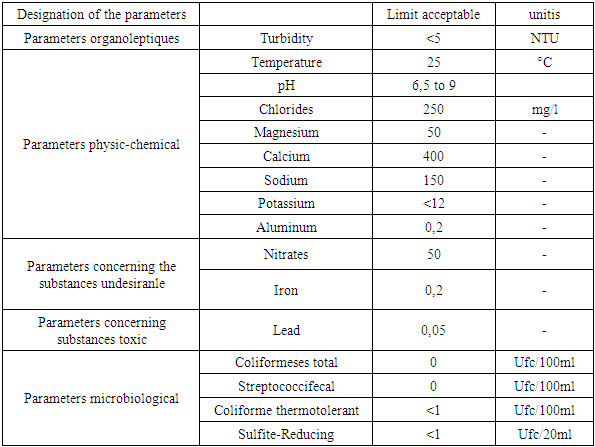 |
| |
|
PARAMETERS OF ANALYSIS- Turbidity: it is the transparency of water.- pH: to know the water is acid, base and neutral, it depends on the variation of this pH.- Conductivity: allows appreciating the quality of salt dissolved in water.- Organic matter: allows estimating the quality of organic matter in water, BOD and COD.- Salinity: it is the measure of the concentration of salt in water.- Alkalimetric title: this is the basic salt content, that is to say to know the concentration of OH- ion in water.- Nitrate assays: determination of the nitrate concentration that exists in water.- Total hardness: determination of the calcium and magnesium content that exist in water.- Iron determinations: to know the concentration of iron in water, it is in the form of trace.- Ammonium: the ammonium ion indicates an existence of pollution in water.- Sodium: is responsible for the hydro-electrolyte balance.- Potassium: plays a role as calcium in human life.- Calcium and magnesium: concentrations are very important in drinking water.- Aluminum, Lead and Copper: are lord metals, their existences in the drinking water doing not accept for the international standards.
2. Results of Measures
I- Physical parameters1- Temperature [3]Table 6. Temperature measurement
 |
| |
|
 | Figure 1. Shows the temperature measurement |
The value of the temperature found is 15.9°C is below 25°C so it is acceptable for international standards.2- Turbidity [4]Table 7. Turbidity measurement
 |
| |
|
 | Figure 2. Shows the Turbidity measurement |
The value of the turbidity found is equal to 1.68 NTU so less than 5 NTU, the water of Lake BEMAPAZA is clear.3- Le pH [3]Table 8. pH measurement
 |
| |
|
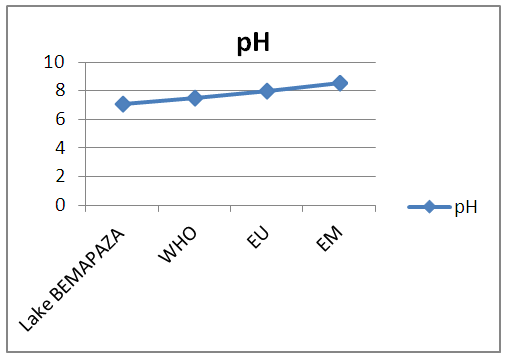 | Figure 3. Shows the pH measurement |
The value of the pH found is equal to 7.04, so it is eligible for the value required for drinking water.4- ConductivityTable 9. Conductivity measurement
 |
| |
|
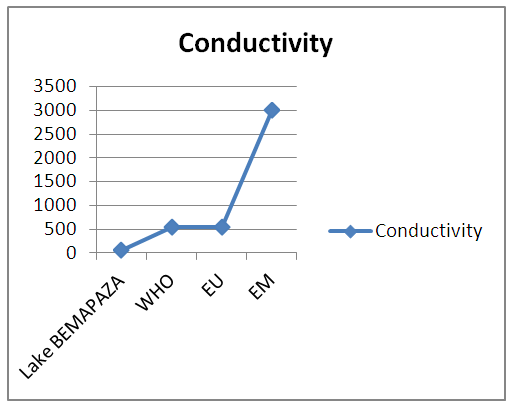 | Figure 4. Shows the Conductivity measurement |
He conductivity value found is 64.7 °f therefore allowable for the standard of potability of water.II- CHEMICAL PARAMETERS1- Dissolved oxygenTable 10. Dissolved oxygen measurement
 |
| |
|
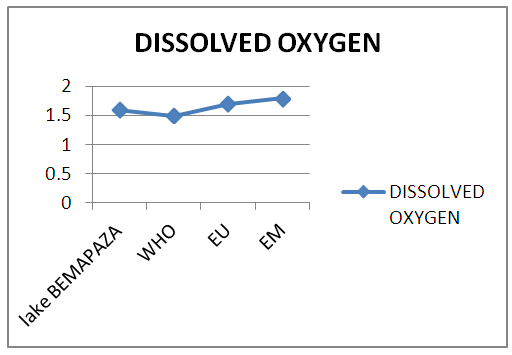 | Figure 5. Shows the Dissolved oxygen measurement |
The amount of organic matter in BEMAPAZA Lake water is low compared to the three standards for drinking water.2- SalinityTable 11. Salinity measurement
 |
| |
|
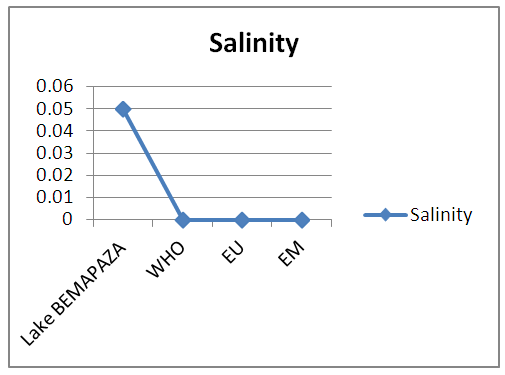 | Figure 6. Shows the Salinity measurement |
The concentration of salt in BEMAPAZA Lake water is a little higher than the standard required for drinking water because the required concentration is 0 mg / L while for lake water is 0.05mg / L.3- Ammonium [6]Table 12. Ammonium measurement
 |
| |
|
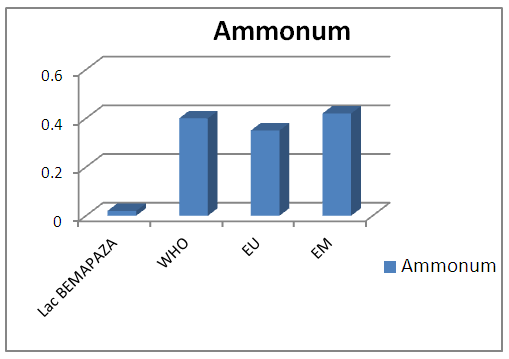 | Figure 7. Shows the Ammonium measurement |
The concentration of ammonium in the lake water is 0.2mg / L, i.e. less than 0.5mg / L the value required for potash water, i.e. the lake water is not polluted.4- Complete alcalimetric title [1]Table 13. Complet Alcalimetric title measurement
 |
| |
|
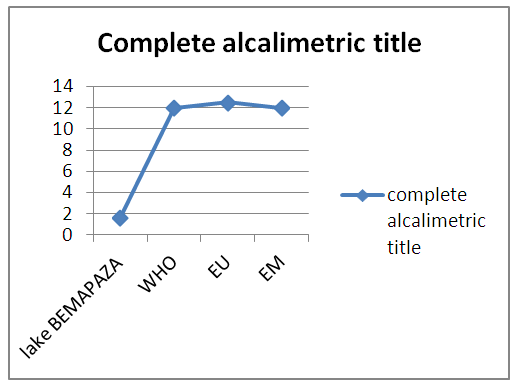 | Figure 8. Shows the Complet Alcalimetric title measurement |
The basic salt content of the lake water is very low because the concentration found is 1.6mg / L, but the required concentration is higher than 11mg / L.5- NitratesTable 14. Nitrates measurement
 |
| |
|
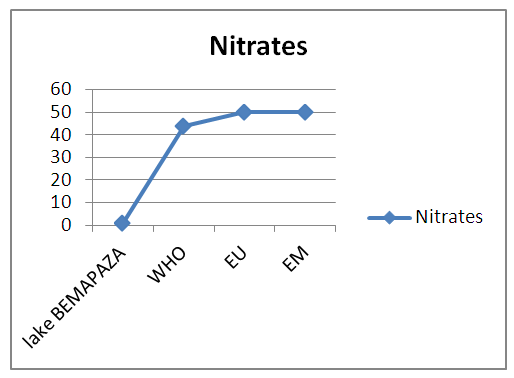 | Figure 9. Shows the Nitrates measurement |
The concentration of Nitrates in the lake water is 0.85mg / L, it is very small compared to the concentration required 44mg / L for WHO.6- Total hardness [11]Table 15. Total hardness measurement
 |
| |
|
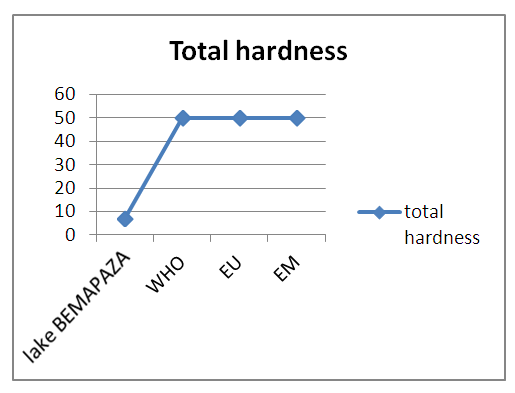 | Figure 10. Shows the Total hardness measurement |
The lake water is not hard because the concentration found is 7.2mg / L, fully eligible in the three international standards 50mg / L.7- Iron dosage [10]Table 16. Iron dosage measurement
 |
| |
|
 | Figure 11. Shows the Iron dosage measurement |
Iron does not exist in the water of Lake BEMAPAZA because the concentration is 0mg / L.8- Sodium [13]Table 17. Sodium measurement
 |
| |
|
 | Figure 12. Shows the Sodium measurement |
The sodium concentration found is 11.5 mg / L, but the required value is 200mg / L for drinking water, so the lake water is low in Sodium.9- Potassium [13]Table 18. Potassium measurement
 |
| |
|
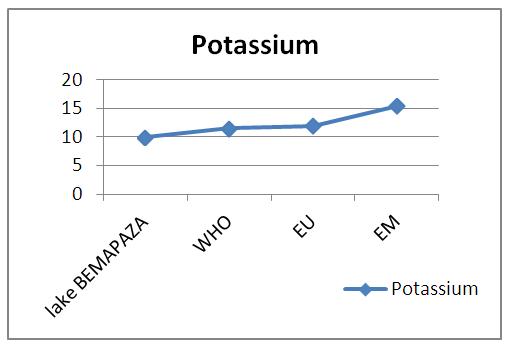 | Figure 13. Shows the Potassium measurement |
The Potassium concentration of the lake water is 10mg / L, so it is normal compared to the concentration required for international standards.10- Calcium [7]Table 19. Calcium measurement
 |
| |
|
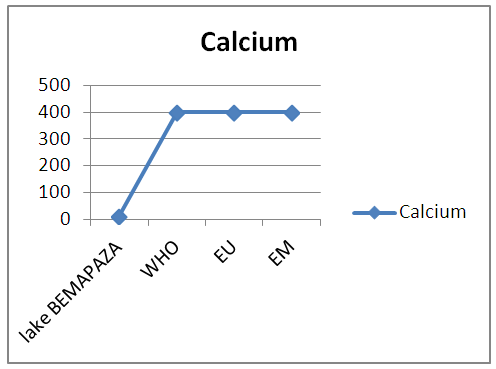 | Figure 14. Shows the Calcium measurement |
The calcium concentration of the lake water is 10.5mg / L, it is very low compared to the value required for drinking water standards 400mg / L.11- Magnesium [11]Table 20. Magnesium measurement
 |
| |
|
 | Figure 15. Shows the Magnesium measurement |
The Magnesium concentration of the lake water is 11.17 mg / L, it is insufficient compared to the value required for drinking water standards 50mg / L.12- Aluminum [5]Table 21. Aluminum measurement
 |
| |
|
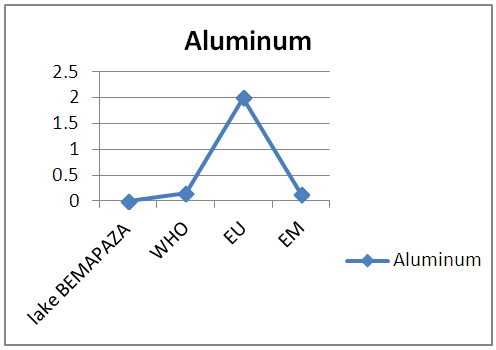 | Figure 16. Shows the Aluminum measurement |
Aluminum does not exist in BEMAPAZA lake water.13- Copper [9]Table 22. Copper measurement
 |
| |
|
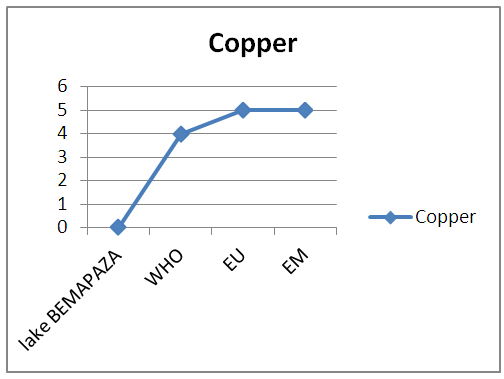 | Figure 17. Shows the Copper measurement |
The concentration of copper is 0.02 mg / L, it is almost negligible compared to the value required for standards of drinking water is less than 5mg / L.14- Lead [5]Table 23. Lead measurement
 |
| |
|
 | Figure 18. Shows the Laed measurement |
Lead does not exist in BEMAPAZA lake water.15- Chloride[8]Table 24. Chloride measurement
 |
| |
|
 | Figure 19. Shows the Chloride measurement |
The concentration of chloride in the water of the lake is 17,75mg / L; it allows the values required for drinking water standards lower 250mg / L, in spite of their insufficiency of the found concentration.
3. Microbiological Analysis [14]
The concentrations of the bacteria found in the lake water are acceptable to the potability standards at the level of microbiological analysis, so the lake water is microbial.Results interpretation:Physical parametersThe temperature is 15.9°C, lower than 25°C, the pH is7.08 between 6.5 to 8.5, the turbidity is 1.68 NTU below 5NTU and the conductivity is 64.7μS / cm included between 180 to 1000 μS / cm; BEMAPAZA Lake water quality control for physical parameters are good compared to drinking water standards.Chemical parametersDissolved oxygen is 1.6 mg / L less than 2 mg / L, salinity is 0.05mg / L greater than 0mg / L, T.A.C is 1.6mg / L less than 11mg / L, Nitrates is 0 85mg / L less than 44mg / L, the total hardness is 7.2mg / L less than 50mg / L, total iron is 0mg / L, ammonium is 0.02mg / L less than 0.5mg / L, sodium is 11.5mg / L less than 200mg / L, Potassium is 10mg / L, less than 12mg / L, calcium 10.4mg / L less than 400mg / L, Magnesium is 11.17mg / L less than 50mg / L, Aluminum is 0mg / L, copper is 0.02 mg / L less than 5mg / L, lead is 0mg / L, and chloride is 17.75mg / L less than 250mg / L; the chemical parameters are acceptable at the standards required for drinking water standards, but there are some deficiencies in the concentrations for calcium, magnesium, sodium and chloride.MicrobiologicalAccording to this concentration found for bacteriological analysis, the water of Lake BEMAPAZA perfectly meets the conditions required for drinking water, that is to say the water is not microbial.Table 25. Measurement results for the bacteria
 |
| |
|
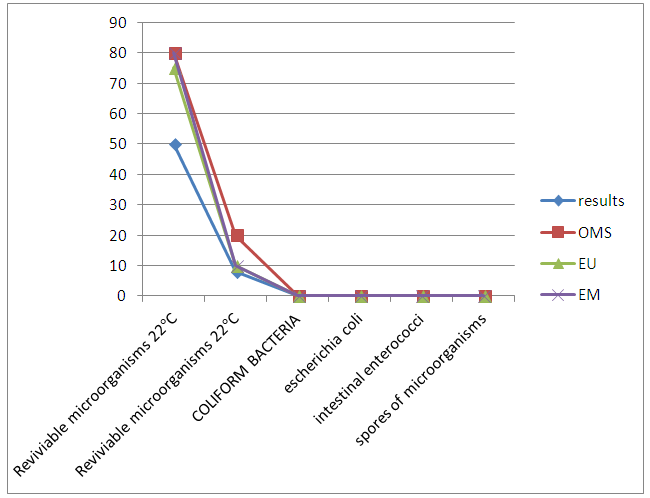 | Figure 20. Shows the Bacteria measurement |
4. Conclusions
To conclude, the physical parameters are eligible for international standards, chemical parameters almost perfectly meets the standards required for drinking water, especially the chloride concentration is 17.75mg / L, magnesium is 11.17mg / L, and in calcium is 104mg / L.Their concentrations are insufficient compared to the required standards.Bacteriological water from Lake BEMAPAZA is not microbial I propose you increased the levels of calcium, potassium, magnesium and chloride by the REMINERALIZATION method.
References
| [1] | S.R JENKINS and R.C. MORE (1977). A proposed modification to the classical method of calculating alkalinity in natural waters. J. Amer. Water Works Assoc. 69/56. |
| [2] | M. DORE (1989). Chimie des oxydants et Traitement des eaux. Tec et Doc Lavoisier, Paris. |
| [3] | W.F. LANGELIER (1964). Effect of temperature on the pH natural waters J.A.W.W.A. 38 p 179. |
| [4] | K.V. GRICORYAN et al. (1991). Error analysis and state estimation in metrological support to turbidity analyzers for natural’s waters and effluents, Measurement Techniques 34. P. 755. |
| [5] | C. I. LIKE, K. C. BRAUN (1952). Photometric determination of aluminium. Anal. Chem, 24. P 1120. |
| [6] | F. KOROLEFF (1969). Direct determination of ammonia in natural waters as indophenols-blue. Intl Council for exploration of the sea: C.M.: 9.19.1969. |
| [7] | P. L. KEMPSTER et al. (1987). Determination of calcium in waters by flow injection analysis-inductively coupled plasma (FIA- ICP)) emission spectrometry, Fresenius Zetschrift fur Analytische Chemie, 2: 153. |
| [8] | T. P. ALEKSANDROWA et YU.B. KLETENIK (1997). Voltammetric analysis of chloride ions in natural. Potable, and effluent waters using a renewable silver electrode, Industrial Laboratory, 63: 581. |
| [9] | G.F. SMITH, W.J. McCURDY (1952). 2, 9-dimethyl-1, 10-phénanthroline; new specific in spectro-photometric determination of copper. Anal. Chem, 24, p. 371. |
| [10] | W.R. SEITZ and D.M. HERCULES (1972). Determination of iron (II) using chemi-luminescence analysis. Anal. Chem, 44: 2143. |
| [11] | K. WATANABE et al. (2003). Fluorometric analysis of a trace amount of magnesium in distilled water by on-line preconcentration using a PTFE capilalary yube, Bunseki Kgaku, 52: 55. |
| [12] | R. PINEL (1991). L’analyse des organométalliques en traces dans l’eau: Arsenic, Etain, Mercure et Plomb, Analusis (paris), 19,2. |
| [13] | J. RODIER, A. POITOUX, C, GRANDE (1952). Détermation du sodium et du potassium par photométrie de flamme. Application au dosage de ces éléments dans le sérum et dans les eaux (Note technique) Bull. de l’inst. D’Hygiène du Maroc, N.S XII, (3 -4), P. 279-283. |
| [14] | B. SARRETTE, C. DANGLOT, R. VILAGNES (1977). A. new method permitting the quantitantive determination of virus present in surface waters, C R Acad Sci. Hebd. Seances, Acad.Sci. D, 285, (15), p. 1359. French. |























 Abstract
Abstract Reference
Reference Full-Text PDF
Full-Text PDF Full-text HTML
Full-text HTML























